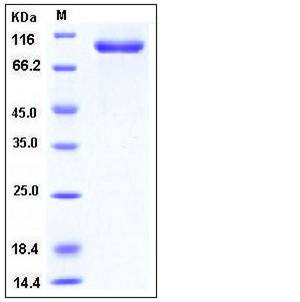Human AGO1 / Argonaute 1 / EIF2C1 Protein (His Tag)
EIF2C,EIF2C1,GERP95,Q99
- 100ug (NPP3566) Please inquiry
| Catalog Number | P11225-H07B |
|---|---|
| Organism Species | Human |
| Host | Baculovirus-Insect Cells |
| Synonyms | EIF2C,EIF2C1,GERP95,Q99 |
| Molecular Weight | The recombinant human AGO1 consists of 875 amino acids and predicts a molecular mass of 99.5 kDa as estimated in SDS-PAGE under reducing conditions. |
| predicted N | His |
| SDS-PAGE |  |
| Purity | > 97 % as determined by SDS-PAGE |
| Protein Construction | A DNA sequence encoding the full length of human AGO1 (NP_036331.1) (Met 1-Ala 857) was expressed, with a polyhistidine tag at the N-terminus. |
| Bio-activity | |
| Research Area | Cancer |Signal transduction |Translational Regulator |
| Formulation | Lyophilized from sterile 50mM Tris, 100mM NaCl, 10% Gly, 0.5 PMSF, 0.5mM EDTA, pH 8.0 1. Normally 5 % - 8 % trehalose, mannitol and 0.01% Tween80 are added as protectants before lyophilization. Specific concentrations are included in the hardcopy of COA. |
| Background | Protein argonaute-1, also known as eukaryotic translation initiation factor 2C 1, EIF2C1, and AGO1, is a member of the argonaute family and ago subfamily. Protein argonaute-1 in humans is encoded by the EIF2C1 gene. This gene is located on chromosome 1 in a cluster of closely related family members including argonaute 3, and argonaute 4. This genomic region is frequently lost in human cancers such as Wilms tumors, neuroblastoma, and carcinomas of the breast, liver, and colon. The human EIF2C1 gene is ubiquitously expressed at low to medium levels. Differential polyadenylation and splicing result in a complex transcriptional pattern. EIF2C1 protein contains one PAZ domain and one Piwi domain. It is required for RNA-mediated gene silencing (RNAi) and transcriptional gene silencing (TGS) of promoter regions which are complementary to bound short antigene RNAs (agRNAs). EIF2C1 binds to short RNAs such as microRNAs (miRNAs) or short interfering RNAs (siRNAs), and represses the translation of mRNAs which are complementary to them. |
| Reference |
